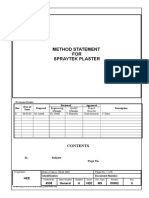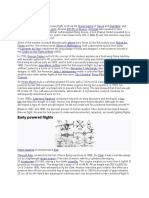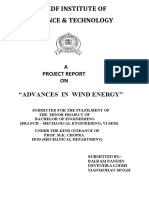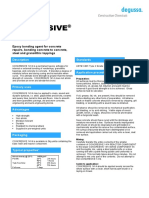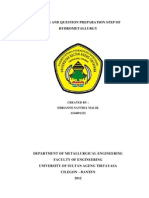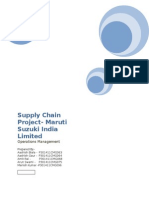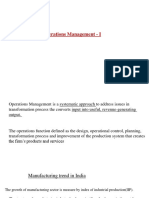Windmill
Windmill
Uploaded by
Sai PrintersCopyright:
Available Formats
Windmill
Windmill
Uploaded by
Sai PrintersCopyright
Available Formats
Share this document
Did you find this document useful?
Is this content inappropriate?
Copyright:
Available Formats
Windmill
Windmill
Uploaded by
Sai PrintersCopyright:
Available Formats
A windmill is a machine that converts the energy of wind into rotational energy by
means of vanes called sails. Originally, windmills were developed for milling grain for
food production. In the course of history, the windmill machinery was adapted to
many other industrial uses. An important non-milling use is to pump water, either for
land drainage or to extract groundwater.
Windmills in antiquity
Heron's wind-powered organ
The windwheel of the Greek engineer Heron of Alexandria in the first century AD is
the earliest known instance of using a wind-driven wheel to power a
machine.
[4][5]
Another early example of a wind-driven wheel was the prayer wheel,
which was used in ancient Tibet and Chinasince the fourth century.
[6]
It has been
claimed that the Babylonian emperor Hammurabi planned to use wind power for his
ambitious irrigation project in the 17th century BC.
Horizontal windmills
The Persian horizontal windmill
Hooper's Mill, Margate, Kent, an 18th-century European horizontal windmill
The first practical windmills had sails that rotated in a horizontal plane, around a
vertical axis.
[8]
According to Ahmad Y. al-Hassan, these anemone were invented in
eastern Persia as recorded by the Persian geographer Estakhri in the 9th
century.
[9][10]
The authenticity of an earlier anecdote of a windmill involving the
second caliph Umar (AD 634644) is questioned on the grounds that it appears in a
10th-century document.
[11]
Made of six to 12 sails covered in reed matting or cloth
material, these windmills were used to grind grain or draw up water, and were quite
different from the later European vertical windmills. Windmills were in widespread
use across the Middle Eastand Central Asia, and later spread to China
and India from there.
A similar type of horizontal windmill with rectangular blades, used for irrigation, can
also be found in 13th-century China (during the Jurchen Jin Dynasty in the north),
introduced by the travels of Yel Chucai to Turkestan in 1219.
[13]
Horizontal windmills were built, in small numbers, in Europe during the 18th and 19th
centuries,
[8]
for example Fowler's Mill at Battersea in London, and Hooper's Mill
at Margate in Kent. These early modern examples seem not to have been directly
influenced by the horizontal windmills of the Middle and Far East, but to have been
independent inventions by engineers influenced by the Industrial Revolution.
Vertical windmills
Due to a lack of evidence, debate occurs among historians as to whether or not
Middle Eastern horizontal windmills triggered the original development of European
windmills. In northwestern Europe, the horizontal-axis or vertical windmill (so called
due to the plane of the movement of its sails) is believed to date from the last quarter
of the 12th century in the triangle of northern France, eastern England and Flanders.
The earliest certain reference to a windmill in Europe (assumed to have been of the
vertical type) dates from 1185, in the former village of Weedley in Yorkshire which
was located at the southern tip of the Wold overlooking the Humber estuary.
[19]
A
number of earlier, but less certainly dated, 12th-century European sources referring
to windmills have also been found. These earliest mills were used to grind cereals.
Post mill
A windmill on the background of the 1792 Battle of Valmy, France
Main article: Post mill
The evidence at present is that the earliest type of European windmill was the post
mill, so named because of the large upright post on which the mill's main structure
(the "body" or "buck") is balanced. By mounting the body this way, the mill is able to
rotate to face the wind direction; an essential requirement for windmills to operate
economically in north-western Europe, where wind directions are variable. The body
contains all the milling machinery. The first post mills were of the sunken type, where
the post was buried in an earth mound to support it. Later, a wooden support was
developed called the trestle. This was often covered over or surrounded by a
roundhouse to protect the trestle from the weather and to provide storage space.
This type of windmill was the most common in Europe until the 19th century, when
more powerful tower and smock mills replaced them.
Hollow-post mill
In a hollow-post mill, the post on which the body is mounted is hollowed out, to
accommodate the drive shaft.
[21]
This makes it possible to drive machinery below or
outside the body while still being able to rotate the body into the wind. Hollow-post
mills driving scoop wheels were used in the Netherlands to drain wetlands from the
14th century onwards.
Tower mill
Main article: Tower mill
By the end of the 13th century, the masonry tower mill, on which only the cap is
rotated rather than the whole body of the mill, had been introduced. The spread of
tower mills came with a growing economy that called for larger and more stable
sources of power, though they were more expensive to build. In contrast to the post
mill, only the cap of the tower mill needs to be turned into the wind, so the main
structure can be made much taller, allowing the sails to be made longer, which
enables them to provide useful work even in low winds. The cap can be turned into
the wind either by winches or gearing inside the cap or from a winch on the tail pole
outside the mill. A method of keeping the cap and sails into the wind automatically is
by using a fantail, a small windmill mounted at right angles to the sails, at the rear of
the windmill. These are also fitted to tail poles of post mills and are common in Great
Britain and English-speaking countries of the former British Empire, Denmark, and
Germany, but rare in other places. Tower mills with fixed caps are found around the
Mediterranean Sea. They are built with the sails facing the prevailing wind direction.
Smock mill
Main article: Smock mill
The smock mill is a later development of the tower mill, where the tower is replaced
by a wooden framework, called the "smock." The smock is commonly of octagonal
plan, though examples with more, or fewer, sides exist. The smock is thatched,
boarded or covered by other materials, such as slate, sheet metal, or tar paper. The
lighter construction in comparison to tower mills make smock mills practical as
drainage mills as these often had to be built in areas with unstable subsoil. Having
originated as a drainage mill, smock mills are also used for a variety of purposes.
When used in a built-up area it is often placed on a masonry base to raise it above
the surrounding buildings.
Sails
Main article: Windmill sail
Common sails consist of a lattice framework on which a sailcloth is spread. The
miller can adjust the amount of cloth spread according to the amount of wind
available and power needed. In medieval mills, the sailcloth was wound in and out of
a ladder type arrangement of sails. Postmedieval mill sails had a lattice framework
over which the sailcloth was spread, while in colder climates, the cloth was replaced
by wooden slats, which were easier to handle in freezing conditions.
[22]
The jib sail is
commonly found in Mediterranean countries, and consists of a simple triangle of
cloth wound round a spar.
In all cases, the mill needs to be stopped to adjust the sails. Inventions in Great
Britain in the late 18th and 19th centuries led to sails that automatically adjust to the
wind speed without the need for the miller to intervene, culminating in patent sails
invented by William Cubitt in 1813. In these sails, the cloth is replaced by a
mechanism of connected shutters.
In France, Berton invented a system consisting of longitudinal wooden slats
connected by a mechanism that lets the miller open them while the mill is turning. In
the 20th century, increased knowledge of aerodynamics from the development of the
airplane led to further improvements in efficiency by German engineer Bilau and
several Dutch millwrights.
The majority of windmills have four sails. Multiple-sailed mills, with five, six or eight
sails, were built in Great Britain (especially in and around the counties
of Lincolnshire andYorkshire), Germany, and less commonly elsewhere. Earlier
multiple-sailed mills are found in Spain, Portugal, Greece, parts of Romania,
Bulgaria, and Russia
[23]
A mill with an even number of sails has the advantage of
being able to run with a damaged sail and the one opposite removed without
resulting in an unbalanced mill.
Machinery
Main article: Mill machinery
Gears inside a windmill convey power from the rotary motion of the sails to a
mechanical device. The sails are carried on the horizontal windshaft. Windshafts can
be wholly made of wood, or wood with a cast iron poll end (where the sails are
mounted) or entirely of cast iron. The brake wheel is fitted onto the windshaft
between the front and rear bearing. It has the brake around the outside of the rim
and teeth in the side of the rim which drive the horizontal gearwheel called wallower
on the top end of the vertical upright shaft. In grist mills, the great spur wheel, lower
down the upright shaft, drives one or more stone nuts on the shafts driving each
millstone. Post mills sometimes have a head and/or tail wheel driving the stone nuts
directly, instead of the spur gear arrangement. Additional gear wheels drive a sack
hoist or other machinery. The machinery differs if the windmill is used for other
applications than milling grain. A drainage mill uses another set of gear wheels on
the bottom end of the upright shaft to drive a scoop wheel or Archimedes'
screw. Sawmillsuse a crankshaft to provide a reciprocating motion to the saws.
Windmills have been used to power many other industrial processes,
including papermills, threshing mills, and to process oil seeds, wool, paints and stone
products.
Spread and decline
The total number of wind-powered mills in Europe is estimated to have been around
200,000 at its peak, compared to some
500,000 waterwheels.
[22]
With the
coming of the industrial revolution, the
importance of wind and water as
primary industrial energy sources
declined and were eventually replaced
by steam (in steam mills) and internal
combustion engines, although
windmills continued to be built in large
numbers until late in the 19th century.
More recently, windmills have been
preserved for their historic value, in
some cases as static exhibits when the
antique machinery is too fragile to put
in motion, and in other cases as fully
working mills. Around 50 working mills
are in operation in Britain as of 2009.
[24]
Of the 10,000 windmills in use in the Netherlands around 1850,
[25]
about 1000 are
still standing. Most of these are being run by volunteers, though some grist mills are
still operating commercially. Many of the drainage mills have been appointed as
backup to the modern pumping stations. The Zaan district has been said to have
been the first industrialized region of the world with around 600 operating wind-
powered industries by the end of the 18th century.
[25]
Economic fluctuations and the
industrial revolution had a much greater impact on these industries than on grain and
drainage mills so only very few are left.
Construction of mills spread to the Cape Colony in the 17th century. The early tower
mills did not survive the gales of the Cape Peninsula, so in 1717, the Heeren
XVII sent carpenters, masons, and materials to construct a durable mill. The mill,
completed in 1718, became known as the Oude Molen and was located between
Pinelands Station and the Black River. Long since demolished, its name lives on as
that of a Technical school in Pinelands. By 1863, Cape Town could boast 11 mills
stretching from Paarden Eiland.
Windpumps
Windpump in South Dakota, USA
Main article: Windpump
Windpumps are used extensively on farms and ranches in the central plains and
southwestern United States and in Southern Africa andAustralia. These mills feature
a large number of blades, so they turn slowly with considerable torque in low winds
and are self-regulating in high winds. A tower-top gearbox and crankshaft convert
the rotary motion into reciprocating strokes carried downward through a rod to the
pump cylinder below. The farm windpump was invented by Daniel Halladay in
1854.
[27][28]
In early California and some other states, the windmill was part of a self-
contained domestic water system including a hand-dug well and a redwood water
tower supporting a redwood tank and enclosed by redwood siding (tankhouse).
Eventually, steel blades and steel towers replaced wooden construction, and at their
peak in 1930, an estimated 600,000 units were in use.
[29]
The multiple-bladed
wind turbine atop a lattice tower made of wood or steel hence became, for many
years, a fixture of the landscape throughout rural America. Firms such as
Star, Eclipse, Fairbanks-Morse and Aermotorbecame famed suppliers in North and
South America.
Wind turbine
Main article: Wind power
A wind turbine is a windmill-like structure specifically developed to generate
electricity. They can be seen as the next step in the developments of the windmill.
The first wind turbines were built by the end of the 19th century by Prof James
Blyth in Scotland (1887),
[30][31]
Charles F. Brush in Cleveland, Ohio (1887
1888)
[32][33][34]
and Poul la Cour in Denmark (1890s). La Cour's mill from 1896 later
became the local powerplant of the village Askov. By 1908, 72 wind-driven electric
generators were in Denmark, ranging from 5 to 25 kW. By the 1930s, windmills were
widely used to generate electricity on farms in the United States where distribution
systems had not yet been installed, built by companies such as Jacobs Wind,
Wincharger, Miller Airlite, Universal Aeroelectric, Paris-Dunn, Airline, and Winpower,
and by the Dunlite Corporation for similar locations in Australia.
Rnland Windpark in Denmark
Forerunners of modern horizontal-axis utility-scale wind generators were the WIME-3D in service
in Balaklava USSR from 1931 until 1942, a 100-kW generator on a 30-m (100-ft)
tower,
[35]
the Smith-Putnam wind turbine built in 1941 on the mountain known as
Grandpa's Knob in Castleton, Vermont, USA of 1.25 MW
[36]
and the NASA wind
turbines developed from 1974 through the mid-1980s. The development of these 13
experimental wind turbines pioneered many of the wind turbine design technologies
in use today, including: steel tube towers, variable-speed generators, composite
blade materials, and partial-span pitch control, as well as aerodynamic, structural,
and acoustic engineering design capabilities. The modern wind power
industry began in 1979 with the serial production of wind turbines by Danish
manufacturers Kuriant, Vestas, Nordtank, and Bonus. These early turbines were
small by today's standards, with capacities of 2030 kW each. Since then, they have
increased greatly in size, with the Enercon E-126 capable of delivering up to 7 MW,
while wind turbine production has expanded to many countries.
As the 21st century began, rising concerns over energy security, global warming,
and eventual fossil fuel depletion led to an expansion of interest in all available forms
of renewable energy. Worldwide, many thousands of wind turbines are now
operating, with a total nameplate capacity of 194,400 MW.
[37]
Europe accounted for
48% of the total in 2009.
List of windmills
Israel
Location
Name of mill
and coordinates
Type Built Notes Photograph
Jerusalem
Montefiore Mill
Jaffa Gate Mill
Tower 1857
[edit]Japan
Location
Name of mill
and
coordinates
Type Built Notes Photograph
Gunma
Prefecture
Smock
Kamiybetsu
Smock
Kita
Smock
Sakura De Liefde Tower 1994
Shodoshima
Tower
The windmill is presented to
Shdo Island
from Milos, Greece.
[edit]Syria
Location
Name of mill
and
coordinates
Type Built Notes Photograph
Homs
Krak des
Chevaliers
Tower
One of the towers had a
windmill (far right in picture).
[1]
Quneitra
Trestle
Pumping mill (Photo)
Tartus
Smock
Photo dated 2007
[edit]Taiwan
Location
Name of mill
and coordinates
Type Built Notes Photograph
Dongshih
Tower
[edit]Thailand
Location
Name of mill
and coordinates
Type Built Notes Photograph
Chiangmai
Hollow post
[edit]Australia
[edit]Australia
See List of windmills in Australia
[edit]New Zealand
Location
Name of mill
and coordinates
Type Built Notes Photograph
Foxton De Molen Smock 2003 De Molen
[edit]Europe
[edit]Austria
Location
Name of mill
and coordinates
Type Built Notes Photograph
Podersdorf am See
Tower
Retz
Tower
Retz (second mill) Tower
[edit]Belarus
Location
Name of mill
and coordinates
Type Built Notes Photograph
Minsk
State Museum of Folk
Architecture and Life
Post
Moved
from Damatkanavichy
Minsk
State Museum of Folk
Architecture and Life
Post
Moved
from Yanushowka
Minsk
Smock
Stroczycy
Post
[edit]Belgium
See List of windmills in Belgium
[edit]Bulgaria
Location
Name of mill
and coordinates
Type Built Notes Photograph
Nesebar
Post
Nesebar
Tower
Nesebar
Tower
Pravda
Post
Sozopol
Post
[edit]Czech Republic
Windmill Ruprechtov, Brno
See List of windmills in the Czech Republic
[edit]Denmark
See List of windmills in Denmark
[edit]Estonia
See List of windmills in Estonia
[edit]Finland
Location
Name of mill
and coordinates
Type Built Notes Photograph
land Islands
Post
land Islands
Post
Jrvenp
Post
Konnevesi Konnevesi Museum Post
Korpostrm, Korpo Hembygdsmuseum Post
Loviisa
Smock
Pudasjrvi
Post
Samppalinna, Turku
Tower 1860
Seurasaari Seurasaari Open Air Museum Post
Sideby
Post
Vaala
Post
stra Simskla, Vrd
Post
Vuonna
Smock
[edit]France
See List of windmills in France
[edit]Germany
See List of windmills in Germany
[edit]Greece
See List of windmills in Greece
[edit]Hungary
Location
Name of mill
and coordinates
Type Built Notes Photograph
Kengyel
Tower
Szegvr
Tower
Szentendre
Tower
Szentes Dnt
Tower Late C19th
Ts
Tower
[edit]Ireland
See List of windmills in Ireland
[edit]Italy
Location
Name of mill
and
coordinates
Type Built Notes Photograph
Margherita di
Savoia
Titt wind
engine
Marsala (two mills) Tower
Pumping mills for
salt works
Mozia
Tower
Pumping mill for salt
works
Orbetello
Tower
[edit]Latvia
Location
Name of mill
and coordinates
Type Built Notes Photograph
Csis
Tower
[edit]Lithuania
Location
Name of mill
and coordinates
Type Built Notes Photograph
Baltoji
Tower
Darbnai
Smock
Obeliai
Tower
eduva Velnio malnas Tower
iauliai aliki malnas Smock 1875-1880
Stainai
Smock
Stultikiai
Smock
Teliai
Smock
Machinery
Main article: Mill machinery
Gears inside a windmill convey power from the rotary motion of the sails to a
mechanical device. The sails are carried on the horizontal windshaft. Windshafts can
be wholly made of wood, or wood with a cast iron poll end (where the sails are
mounted) or entirely of cast iron. The brake wheel is fitted onto the windshaft
between the front and rear bearing. It has the brake around the outside of the rim
and teeth in the side of the rim which drive the horizontal gearwheel called wallower
on the top end of the vertical upright shaft. In grist mills, the great spur wheel, lower
down the upright shaft, drives one or more stone nuts on the shafts driving each
millstone. Post mills sometimes have a head and/or tail wheel driving the stone nuts
directly, instead of the spur gear arrangement. Additional gear wheels drive a sack
hoist or other machinery. The machinery differs if the windmill is used for other
applications than milling grain. A drainage mill uses another set of gear wheels on
the bottom end of the upright shaft to drive a scoop wheel or Archimedes'
screw. Sawmills use a crankshaft to provide a reciprocating motion to the saws.
Windmills have been used to power many other industrial processes,
including papermills, threshing mills, and to process oil seeds, wool, paints and stone
products.
An isometric drawing of the machinery of theBeebe Windmill
Diagram of the smock millat Meopham, Kent
Cross section of a post mill
Windshaft, brake wheel, and brake blocks in smock mill d'Admiraal inAmsterdam
Interior view, Pantigo windmill, East Hampton, New York Historic American Buildings Survey
Technical drawing of a 1793 Dutch tower mill for land drainage
Spread and decline
Oilmill De Zoeker, paintmill De Kat and paltrok sawmill De Gekroonde Poelenburg at the Zaanse Schans
The total number of wind-powered mills in Europe is estimated to have been around
200,000 at its peak, compared to some 500,000 waterwheels.
[22]
With the coming of
the industrial revolution, the importance of wind and water as primary industrial
energy sources declined and were eventually replaced by steam (in steam mills)
and internal combustion engines, although windmills continued to be built in large
numbers until late in the 19th century. More recently, windmills have been preserved
for their historic value, in some cases as static exhibits when the antique machinery
is too fragile to put in motion, and in other cases as fully working mills. Around 50
working mills are in operation in Britain as of 2009.
Of the 10,000 windmills in use in the Netherlands around 1850,
[25]
about 1000 are
still standing. Most of these are being run by volunteers, though some grist mills are
still operating commercially. Many of the drainage mills have been appointed as
backup to the modern pumping stations. The Zaan district has been said to have
been the first industrialized region of the world with around 600 operating wind-
powered industries by the end of the 18th century. Economic fluctuations and the
industrial revolution had a much greater impact on these industries than on grain and
drainage mills so only very few are left.
Construction of mills spread to the Cape Colony in the 17th century. The early tower
mills did not survive the gales of the Cape Peninsula, so in 1717, theHeeren
XVII sent carpenters, masons, and materials to construct a durable mill. The mill,
completed in 1718, became known as the Oude Molen and was located between
Pinelands Station and the Black River. Long since demolished, its name lives on as
that of a Technical school in Pinelands. By 1863, Cape Town could boast 11 mills
stretching from Paarden Eiland to Mowbray.
Windpumps
Windpump in South Dakota, USA
Main article: Windpump
Windpumps are used extensively on farms and ranches in the central plains and
southwestern United States and in Southern Africa and Australia. These mills feature
a large number of blades, so they turn slowly with considerable torque in low winds
and are self-regulating in high winds. A tower-top gearboxand crankshaft convert the
rotary motion into reciprocating strokes carried downward through a rod to the pump
cylinder below. The farm windpump was invented by Daniel Halladay in
1854.
[27][28]
In early California and some other states, the windmill was part of a self-
contained domestic water system including a hand-dug well and a redwood water
tower supporting a redwood tank and enclosed by redwood siding (tankhouse).
Eventually, steel blades and steel towers replaced wooden construction, and at their
peak in 1930, an estimated 600,000 units were in use.
[29]
The multiple-bladed
wind turbine atop a lattice tower made of wood or steel hence became, for many
years, a fixture of the landscape throughout rural America. Firms such as
Star, Eclipse,Fairbanks-Morse and Aermotor became famed suppliers in North and
South America.
Wind turbine
Main article: Wind power
A wind turbine is a windmill-like structure specifically developed to generate
electricity. They can be seen as the next step in the developments of the windmill.
The first wind turbines were built by the end of the 19th century by Prof James
Blyth in Scotland (1887), Charles F. Brush in Cleveland, Ohio (1887
1888)
[32][33][34]
and Poul la Cour in Denmark (1890s). La Cour's mill from 1896 later
became the local powerplant of the village Askov. By 1908, 72 wind-driven electric
generators were in Denmark, ranging from 5 to 25 kW. By the 1930s, windmills were
widely used to generate electricity on farms in the United States where distribution
systems had not yet been installed, built by companies such as Jacobs Wind,
Wincharger, Miller Airlite, Universal Aeroelectric, Paris-Dunn, Airline, and Winpower,
and by the Dunlite Corporation for similar locations in Australia.
Rnland Windpark in Denmark
Forerunners of modern horizontal-axis utility-scale wind generators were the WIME-
3D in service in Balaklava USSR from 1931 until 1942, a 100-kW generator on a 30-
m (100-ft) tower,
[35]
the Smith-Putnam wind turbine built in 1941 on the mountain
known as Grandpa's Knob in Castleton, Vermont, USA of 1.25 MW
[36]
and the NASA
wind turbines developed from 1974 through the mid-1980s. The development of
these 13 experimental wind turbines pioneered many of the wind turbine
design technologies in use today, including: steel tube towers, variable-speed
generators, composite blade materials, and partial-span pitch control, as well as
aerodynamic, structural, and acoustic engineering design capabilities. The
modern wind power industry began in 1979 with the serial production of wind
turbines by Danish manufacturers Kuriant, Vestas, Nordtank, and Bonus. These
early turbines were small by today's standards, with capacities of 2030 kW each.
Since then, they have increased greatly in size, with the Enercon E-126 capable of
delivering up to 7 MW, while wind turbine production has expanded to many
countries.
As the 21st century began, rising concerns over energy security, global warming,
and eventual fossil fuel depletion led to an expansion of interest in all available forms
of renewable energy. Worldwide, many thousands of wind turbines are now
operating, with a total nameplate capacity of 194,400 MW. Europe accounted for
48% of the total in 2009.
You might also like
- PWC-Developing Business Plan Example - GenericoDocument44 pagesPWC-Developing Business Plan Example - GenericoSyed Muhammad KamranNo ratings yet
- Method Statement 2 - Spraytek PlasterDocument6 pagesMethod Statement 2 - Spraytek PlasterMohammad Arif RasheedNo ratings yet
- The Textile MagazineDocument110 pagesThe Textile MagazineKayPeaB100% (2)
- Chapter02.Basic Cost Management Concepts and Accounting For Mass Customization OperationsDocument31 pagesChapter02.Basic Cost Management Concepts and Accounting For Mass Customization OperationsHecel Olita100% (2)
- ADI WordDocument8 pagesADI WordAshutosh GuptaNo ratings yet
- Wind MillDocument12 pagesWind Milltajju_121No ratings yet
- Wind MachinesDocument34 pagesWind Machinesjeswin johnsonNo ratings yet
- Vertical Windmills: Post MillDocument2 pagesVertical Windmills: Post MillCleng LaynesNo ratings yet
- WindmillDocument20 pagesWindmillG Manoj NairNo ratings yet
- WindmillDocument9 pagesWindmillAbhi HandaNo ratings yet
- 5 Smart Uses For WindDocument12 pages5 Smart Uses For WindmadhaviNo ratings yet
- WindmillDocument15 pagesWindmillMokhammad Richard FirdausNo ratings yet
- 1 Windmills and WindwheelsDocument21 pages1 Windmills and WindwheelsHmaedNo ratings yet
- Wind Power: Sails Wind-Powered MachinesDocument29 pagesWind Power: Sails Wind-Powered Machinestusharmali99No ratings yet
- Windmill details AkDocument4 pagesWindmill details AkArun kumarNo ratings yet
- Vishnu 1Document5 pagesVishnu 1KIRAN KENNo ratings yet
- Hgass WindDocument13 pagesHgass Windhadush gebreNo ratings yet
- Wind Energy: Windmill: Mill Energy of Wind Rotational Sails Mill Gristmills Windpumps Wind Turbines WindpumpsDocument3 pagesWind Energy: Windmill: Mill Energy of Wind Rotational Sails Mill Gristmills Windpumps Wind Turbines WindpumpsSwarg VibhaNo ratings yet
- Report On Wind MillDocument4 pagesReport On Wind MillAnonymous ytZsBOVNo ratings yet
- History of Wind UsesDocument55 pagesHistory of Wind Usessnemo30No ratings yet
- Offshore Wind TurbineDocument86 pagesOffshore Wind TurbineFaheem MushtaqNo ratings yet
- Wind Energy ConversionDocument17 pagesWind Energy ConversionAjith KrishnanNo ratings yet
- Wind Turbine - Wikipedia, The Free EncyclopediaDocument17 pagesWind Turbine - Wikipedia, The Free EncyclopediaAbhishek SachanNo ratings yet
- Wind Turbine - Wikipedia, The Free EncyclopediaDocument15 pagesWind Turbine - Wikipedia, The Free Encyclopediarrr2013No ratings yet
- Dr. Uday Dokras: Harnessing The Wind and Water by TOWERSDocument36 pagesDr. Uday Dokras: Harnessing The Wind and Water by TOWERSUday DokrasNo ratings yet
- Wind Farms: History of WindmilssDocument3 pagesWind Farms: History of WindmilssAlan PetkovskiNo ratings yet
- Eolic Energy: Diana Bernadac Manuel Segura Jesús RodriguezDocument10 pagesEolic Energy: Diana Bernadac Manuel Segura Jesús RodriguezRoberto RockdriguezNo ratings yet
- EngineDocument3 pagesEnginecool47guy09No ratings yet
- Wind Turbine: Muhammed Muzammilk.V Roll No: 40Document16 pagesWind Turbine: Muhammed Muzammilk.V Roll No: 40Muzammil MuhammedNo ratings yet
- HOA Industrial Tale-Group 1Document28 pagesHOA Industrial Tale-Group 1Abijith AshrafNo ratings yet
- ScienceDocument50 pagesScienceKaren JoseNo ratings yet
- Antecedents: Codex On The Flight of BirdsDocument13 pagesAntecedents: Codex On The Flight of BirdsJordan MosesNo ratings yet
- Cotton Mill and Water: Factory Spinning Weaving Machinery Cotton Industrial Revolution Mechanisation Machine ToolDocument34 pagesCotton Mill and Water: Factory Spinning Weaving Machinery Cotton Industrial Revolution Mechanisation Machine ToolDhruv PatelNo ratings yet
- 103 - Sail-Type Wind-Turbines - A Review and Annotated BibliographyDocument14 pages103 - Sail-Type Wind-Turbines - A Review and Annotated BibliographyMayra ZezattiNo ratings yet
- 13 Inventions - Docx HistoryDocument13 pages13 Inventions - Docx HistoryMohammed Hashim AhmedNo ratings yet
- Wind EnergyDocument18 pagesWind EnergydineshvhavalNo ratings yet
- MMO Ship Propulsion Systems - 01 - TextDocument14 pagesMMO Ship Propulsion Systems - 01 - TexthamidzomorrodipNo ratings yet
- Wind 2Document1 pageWind 2dwight.sahidNo ratings yet
- Ebook WindjammerDocument5 pagesEbook WindjammerMarcelo José de SouzaNo ratings yet
- Wind Energy (ENER 412)Document60 pagesWind Energy (ENER 412)Bruktawit MekonenNo ratings yet
- A Technical Seminar Report On Floating Mindmills: Mechanical EngineeringDocument31 pagesA Technical Seminar Report On Floating Mindmills: Mechanical Engineeringswati dilip jaybhayeNo ratings yet
- Wind TurbineDocument12 pagesWind TurbineDhesa HidayatNo ratings yet
- Advances in Wind EnergyDocument66 pagesAdvances in Wind EnergyArshadali Ansari100% (2)
- Industrial RevolutionDocument35 pagesIndustrial Revolutionpxq57077No ratings yet
- World History II 3cDocument2 pagesWorld History II 3cPerlyn Rose Padron OdevilasNo ratings yet
- Wind Power GenerationDocument77 pagesWind Power GenerationsherifmoussaNo ratings yet
- Steam Engine Piston Thomas Newcomen Cornwall James Watt Jonathan Hornblower Arthur Woolf William Mcnaught (Glasgow)Document7 pagesSteam Engine Piston Thomas Newcomen Cornwall James Watt Jonathan Hornblower Arthur Woolf William Mcnaught (Glasgow)Principal GPJNo ratings yet
- History of Gas Turbine EnginesDocument13 pagesHistory of Gas Turbine EnginesLander MontojoNo ratings yet
- Steamship: Screw Steamer (Using A Propeller or Screw) - As Paddle SteamersDocument9 pagesSteamship: Screw Steamer (Using A Propeller or Screw) - As Paddle SteamersJa KovNo ratings yet
- Historia de Los AerogeneradoresDocument8 pagesHistoria de Los AerogeneradoresHumberto MerizaldeNo ratings yet
- Propeller - Wikipedia, The Free EncyclopediaDocument14 pagesPropeller - Wikipedia, The Free EncyclopediadavidshaneNo ratings yet
- Wind Turbine From Wikipedia (A Better Copy)Document15 pagesWind Turbine From Wikipedia (A Better Copy)noelgdunnNo ratings yet
- Wind CompilationDocument31 pagesWind CompilationMohd. Mustakim Bin Ahmad OthmanNo ratings yet
- 07 The Industrial RevolutionDocument3 pages07 The Industrial RevolutionHeidy Teresa MoralesNo ratings yet
- Coal MiningDocument29 pagesCoal MiningAyalew TebejeNo ratings yet
- Lesson 6: The State of Science and Technology During The Middle AgesDocument3 pagesLesson 6: The State of Science and Technology During The Middle AgesChristian Jay CusayNo ratings yet
- History ProjectDocument14 pagesHistory Projectvaghelashweta92No ratings yet
- Steam ShovelDocument1 pageSteam ShovelakununtukpenggunaamrahasiaNo ratings yet
- Intro To Wind Turbine TechnologyDocument38 pagesIntro To Wind Turbine Technologymayank singhNo ratings yet
- History and Evolution of Aviation EnginesDocument13 pagesHistory and Evolution of Aviation EnginesScribdTranslationsNo ratings yet
- Wind TurbineDocument24 pagesWind TurbinerjiyfrauefaboovyohNo ratings yet
- Jacob S. Gibbs Brinsley ColeberdDocument6 pagesJacob S. Gibbs Brinsley Coleberdjolly antNo ratings yet
- SurveyingDocument1 pageSurveyingSai PrintersNo ratings yet
- Thermal Overload ProtectorDocument69 pagesThermal Overload ProtectorSai Printers100% (1)
- Dcs 1Document12 pagesDcs 1Sai PrintersNo ratings yet
- 8TH LastDocument19 pages8TH LastSai PrintersNo ratings yet
- St. Attri Public School: "Genes and Genetic Disorders"Document25 pagesSt. Attri Public School: "Genes and Genetic Disorders"Sai PrintersNo ratings yet
- 1.write A Program To Print A Message in C LanguageDocument11 pages1.write A Program To Print A Message in C LanguageSai PrintersNo ratings yet
- Ingersoll-Rand (India) LimitedDocument64 pagesIngersoll-Rand (India) LimitedSai PrintersNo ratings yet
- Embeeded SystemDocument53 pagesEmbeeded SystemSai PrintersNo ratings yet
- Railway NarkatiaganjDocument51 pagesRailway NarkatiaganjSai PrintersNo ratings yet
- KDocument75 pagesKSai PrintersNo ratings yet
- Assessment Report: Marks To Be Awarded by The Training Manager / Authorized SignatoryDocument1 pageAssessment Report: Marks To Be Awarded by The Training Manager / Authorized SignatorySai PrintersNo ratings yet
- Training Report: Six Months Practical Training Undertaken, ATDocument4 pagesTraining Report: Six Months Practical Training Undertaken, ATSai PrintersNo ratings yet
- Varroc: Corporate PresentationDocument18 pagesVarroc: Corporate PresentationSai PrintersNo ratings yet
- HFCL ProjectDocument67 pagesHFCL ProjectSai PrintersNo ratings yet
- Project Report AjayDocument52 pagesProject Report AjaySai PrintersNo ratings yet
- BOSCH Automative Aftermarket: Project Report OnDocument1 pageBOSCH Automative Aftermarket: Project Report OnSai PrintersNo ratings yet
- Rays Engineering Services: (A Name For Industrial Products)Document1 pageRays Engineering Services: (A Name For Industrial Products)Sai PrintersNo ratings yet
- "Solar Power Water Pumping System": Project Report ONDocument38 pages"Solar Power Water Pumping System": Project Report ONSai PrintersNo ratings yet
- FJD Company Introduction V1Document5 pagesFJD Company Introduction V1zdlcfNo ratings yet
- Process Selection Written ReportDocument11 pagesProcess Selection Written Reportkarina gayosNo ratings yet
- AssignmentDocument9 pagesAssignmentJuliene HindsNo ratings yet
- Study of Mechanical Properties of AISI 316 Stainless SteelDocument9 pagesStudy of Mechanical Properties of AISI 316 Stainless SteeljasvindersinghsagguNo ratings yet
- 14 Bernardo Soustruhy deDocument40 pages14 Bernardo Soustruhy deTanase Constantin0% (1)
- CH 5 Plastic ProcessingDocument23 pagesCH 5 Plastic ProcessingSahibsartaj Dhaliwal83% (6)
- TDS - Concresive 1414Document2 pagesTDS - Concresive 1414Venkata RaoNo ratings yet
- ProblemasDocument18 pagesProblemasDaria Marlene Rodriguez OlveraNo ratings yet
- Answer and Question Preparation Step of Hydro MetallurgyDocument4 pagesAnswer and Question Preparation Step of Hydro MetallurgyEbrianto Sattria MalikNo ratings yet
- Om FinalDocument18 pagesOm FinalHarleena BhelaNo ratings yet
- Global Dimensions of Supply ChainDocument18 pagesGlobal Dimensions of Supply ChainGh LimNo ratings yet
- Bedri Operation Management AssignmentDocument40 pagesBedri Operation Management AssignmentBedri M Ahmedu100% (2)
- Warning Mat BrochureDocument2 pagesWarning Mat BrochureankeshkatochNo ratings yet
- CONVEYORSDocument60 pagesCONVEYORSJose O. Llaneta IIINo ratings yet
- Supply Chain Management - MSILDocument15 pagesSupply Chain Management - MSILGajananNo ratings yet
- Sheet Metal FormingDocument26 pagesSheet Metal FormingsyedamiriqbalNo ratings yet
- Operations Management - IDocument16 pagesOperations Management - IAnurag SharmaNo ratings yet
- Stud Welding Stud and Ferrule CatalogDocument107 pagesStud Welding Stud and Ferrule Catalogkoulis13No ratings yet
- Solartech PE 55Document2 pagesSolartech PE 55dharamvirpmpNo ratings yet
- Triumph Akademie SolidworksDocument16 pagesTriumph Akademie Solidworkskavi_soniiNo ratings yet
- SKF Bearing DesignationsDocument0 pagesSKF Bearing DesignationsPatrick BaridonNo ratings yet
- Different Types of Packaging MaterialsDocument43 pagesDifferent Types of Packaging MaterialsShailesh Jadhav50% (2)
- Retail Supply Chain: Professor Edward FoxDocument23 pagesRetail Supply Chain: Professor Edward FoxPriyanka SarkarNo ratings yet
- Mix Design of Structural Self-Compacting Concrete Using Void-Bulk Density MethodDocument11 pagesMix Design of Structural Self-Compacting Concrete Using Void-Bulk Density MethodPtpgStucNo ratings yet
- 0082Document1 page0082buddhansamratNo ratings yet

